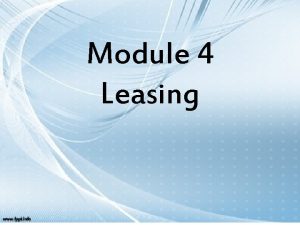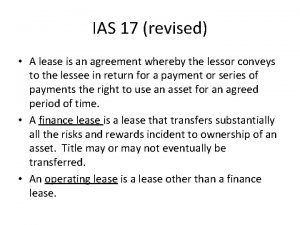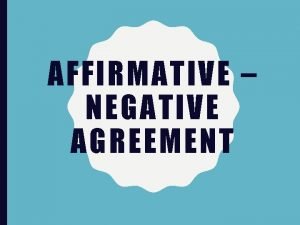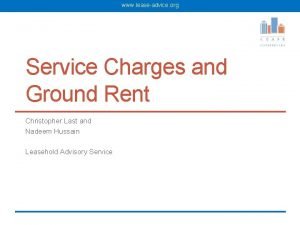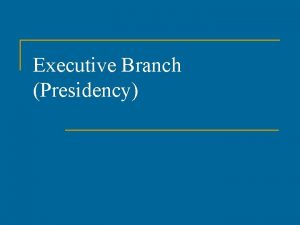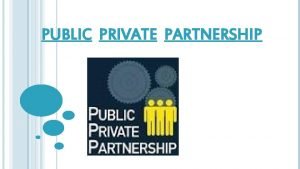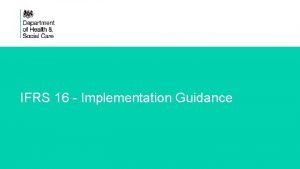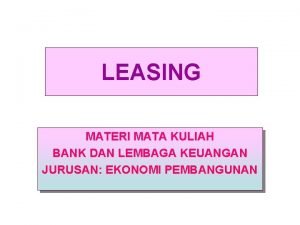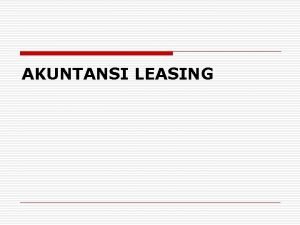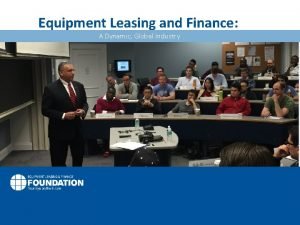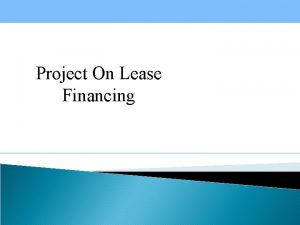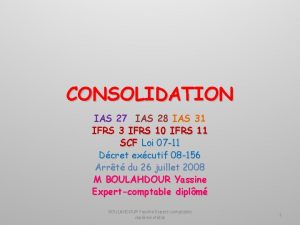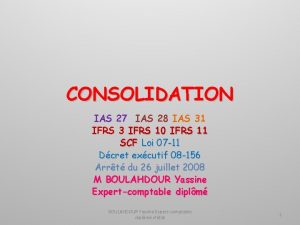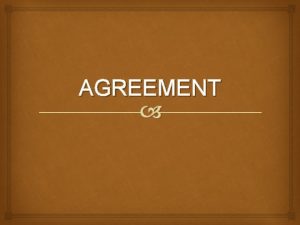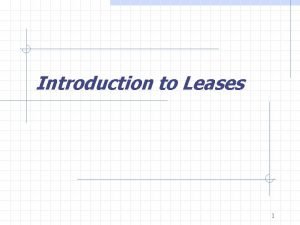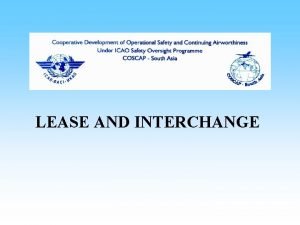IAS 17 revised A lease is an agreement











- Slides: 11

IAS 17 (revised) • A lease is an agreement whereby the lessor conveys to the lessee in return for a payment or series of payments the right to use an asset for an agreed period of time. • A finance lease is a lease that transfers substantially all the risks and rewards incident to ownership of an asset. Title may or may not eventually be transferred. • An operating lease is a lease other than a finance lease.

Finance Lease • A finance lease or capital lease is a commercial arrangement where: – the lessee (customer or borrower) will select an asset (equipment, vehicle, software); – the lessor (finance company) will purchase that asset; – the lessee will have use of that asset during the lease; – the lessee will pay a series of rentals or installments for the use of that asset; – the lessor will recover a large part or all of the cost of the asset plus earn interest from the rentals paid by the lessee; – the lessee has the option to acquire ownership of the asset (e. g. paying the last rental, or bargain option purchase price);

Operating Lease • In an operating lease, the lessor (or owner) transfers only the right to use the property to the lessee. At the end of the lease period, the lessee returns the property to the lessor. Usually the contract period is shorter than the life of the equipment, and the lessor pays all maintenance and servicing costs. • Since the lessee does not assume the risk of ownership, the lease expense is treated as an operating expense in the income statement and the lease does not affect the balance sheet.

Accounting for Lease in the Italian context According to the Italian GAAP, leased fixed assets are recorded by the lessee in the off-balance sheet items, since they are not owned by the company. Leasing contracts, regardless whether financial or operating, produce an expense (B 8 in the Income Statement): the expense corresponds to the periodic fee charged to the lessee. If an extra-fee is paid in advance, it is deferred over the whole period considered in the contract (prepaid expense).

Finance Lease: the IAS perspective • The finance company is the legal owner of the asset during duration of the lease. However the lessee has control over the asset providing them the benefits and risks of (economic) ownership. • Consequently, the lease, when signed, is recognized both as an asset and as a liability (for the lease payments) on the balance sheet. The firm gets to claim depreciation each year on the asset and also deducts the interest expense component of the lease payment each year.

Finance Lease according to IAS 17 • Transactions and other events are accounted for and presented in accordance with their substance and financial reality and not merely with legal form. • Lessees should recognise finance leases as assets and liabilities in their balance sheets at amounts equal at the inception of the lease to the fair value of the leased property or, if lower, at the present value of the minimum lease payments. In calculating the present value of the minimum lease payments the discount factor is the interest rate implicit in the lease, if this is practicable to determine; if not, the lessee's incremental borrowing rate should be used.

Finance Lease according to IAS 17 (revised) • A finance lease is recognised in the lessee's balance sheet both as an asset and as an obligation to pay future lease payments. At the inception of the lease, the asset and the liability for the future lease payments are recognised in the balance sheet at the same amounts • A finance lease gives rise to a depreciation expense for the depreciable assets as well as a finance expense for each accounting period. The depreciation policy for depreciable leased assets should be consistent with that for depreciable assets which are owned

An example • At the beginning of period (X 1) the company signs a finance lease contract. • The company will pay three annual instalments, each of 12 K €. • The purchase price of the lease, after 3 years, amounts to 4 K €. • The economic life of the asset is 4 years (n=4). • The carrying amount of the asset corresponds to the sum of the instalments and of the final purchase price, net of interest charge. • An interest rate of 14% is assumed. VALUE OF THE ASSET: 14 (12 x 1, 14)-(n-1) = 34, 46 K €. INTERESTS: 40 – 34, 46= 5, 54 PAYMENT OF THE FIRST INSTALMENT: 1/1 YEAR X 1 LIABILITY AT THE END OF THE FIRST YEAR: 34, 46 -12=22, 46 plus the interest charge at 14%, i. e. 3, 14; the total liability at the end of the period amounts to 25, 60 K€.

Finance Lease: an example Financial period Net Present Value of the Lease 1/1 Fee (B) (A) 1 2 3 4 Total Interest charge Depreciation (D=A/4) (C=A-B*0, 14) 34, 46 25, 60 15, 51 4, 00 12 12 12 4 40 3, 14 1, 90 0, 49 5, 54 8, 61 34, 46 Liability at 12/31 (E=A-B+C) 25, 60 15, 50 4, 00 0

Finance Lease in the IAS 17 : an example 1/1 Equipments X (lease) Lease liability Interest charge @ Lease liability @ Bank 12/31 Depreciation of eq. X @ Accumulated depreciation of eq. Income Summary @Deprec. of eq. X Interest Charge 34, 46 8, 86 3, 14 12, 00 8, 61 11, 75 8, 61 3, 14

Finance Lease in the IAS 17 : an example BALANCE SHEET 1 INCOME STATEMENT 1 ASSETS: EQUIPMENT: 25, 85 (net of acc. depreciation) EXPENSES: DEPRECIATION: 8, 61 LIABILITY: EASE LIABILITY: 25, 60 BANK: 12 INTEREST CHARGE: 3, 14 BALANCE: 11, 75
